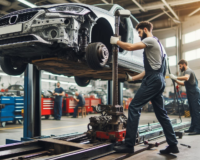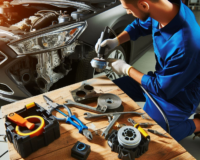The Aluminum Repair Conundrum: Debunking Myths and Navigating Challenges
Introduction
As automotive technology evolves, so do the materials used in vehicle construction. One such material gaining prominence is aluminum. Lightweight, corrosion-resistant, and strong, aluminum is now common in modern vehicles. However, its use presents unique challenges for collision repair centers. Let’s explore the aluminum repair conundrums and separate fact from fiction.
Myth: Aluminum Repairs Are Too Expensive and Time-Consuming
Reality: While aluminum repairs require specialized tools and expertise, they are entirely feasible. Here’s why:
- Specialized Equipment: Aluminum welding and shaping demand-specific tools. Collision centers invest in these tools to ensure precise repairs.
- Certified Technicians: Skilled technicians undergo training to handle aluminum repairs. Their expertise ensures quality work.
- Cost-Effective in the Long Run: Aluminum’s lightweight nature improves fuel efficiency. Repairing aluminum components rather than replacing them can save money over the vehicle’s lifetime.
The Aluminum Repair Process
- Assessment: Technicians assess the damage and determine whether aluminum repair is possible. They consider factors like panel thickness, location, and structural integrity.
- Welding Techniques: Traditional steel welding won’t work for aluminum. Collision centers use specialized MIG or TIG welding techniques designed for aluminum.
- Heat Management: Aluminum dissipates heat quickly. Technicians must manage welding temperatures to prevent warping or weakening.
-
Corrosion Protection: Aluminum corrodes when exposed to steel. Proper isolation and protective coatings are crucial.
Common Aluminum Repair Challenges
- Hidden Damage: Aluminum panels can hide internal damage. Technicians use ultrasound or X-rays to detect hidden fractures.
- Work Area Separation: Collision centers must separate aluminum repair areas from steel repair zones to prevent cross-contamination.
- Aluminum Dust: Sanding aluminum generates fine dust particles that pose health risks. Proper protective gear and dust extraction systems are essential.
Choosing the Right Collision Center
When seeking frame straightening services:
- Certification: Look for centers certified in aluminum repair. Certification ensures adherence to industry standards.
- Experience: Ask about the technicians’ experience with aluminum repairs. Familiarity with different aluminum alloys matters.
- Warranty: Inquire about warranties specific to aluminum repairs. A reputable center stands by its work.
Conclusion
The aluminum repair conundrum isn’t insurmountable. With the right tools, skilled technicians, and proper procedures, collision centers can confidently handle aluminum repairs. As more vehicles incorporate aluminum, staying informed and prepared is essential.
#AluminumRepair #CollisionRepair #AutoBody #AluminumWelding




